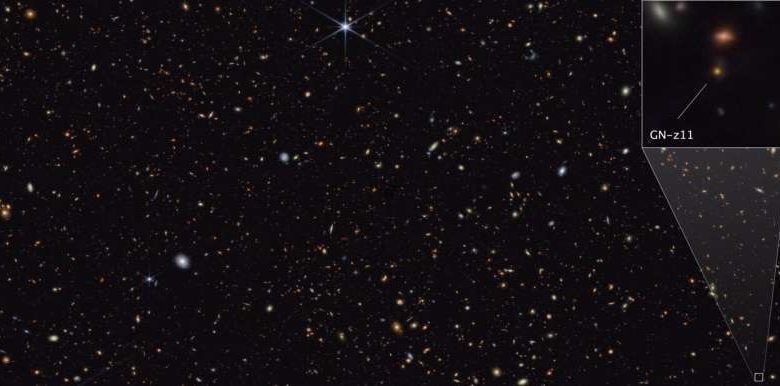Webb unlocks secrets of primeval galaxy

Looking deep into space and time, two teams using the NASA/ESA/CSA James Webb Space Telescope have studied the exceptionally luminous galaxy GN-z11, which existed when our 13.8 billion-year-old universe was only about 430 million years old.
Delivering on its promise to transform our understanding of the early universe, the James Webb Space Telescope is probing galaxies near the dawn of time. One of these is the exceptionally luminous galaxy GN-z11, which existed when the universe was just a tiny fraction of its current age. Initially detected with the NASA/ESA Hubble Space Telescope, it is one of the youngest and most distant galaxies ever observed, and it is also one of the most enigmatic. Why is it so bright? Webb appears to have found the answer.
A team studying GN-z11 with Webb found the first clear evidence that the galaxy is hosting a central, supermassive black hole that is rapidly accreting matter. Their finding makes this the most distant active supermassive black hole spotted to date.
“We found extremely dense gas that is common in the vicinity of supermassive black holes accreting gas,” explained principal investigator Roberto Maiolino of the Cavendish Laboratory and the Kavli Institute of Cosmology at the University of Cambridge in the United Kingdom. “These were the first clear signatures that GN-z11 is hosting a black hole that is gobbling matter.”
Using Webb, the team also found indications of ionized chemical elements typically observed near accreting supermassive black holes. Additionally, they discovered that the galaxy is expelling a very powerful wind. Such high-velocity winds are typically driven by processes associated with vigorously accreting supermassive black holes.
“Webb’s NIRCam (Near-Infrared Camera) has revealed an extended component, tracing the host galaxy, and a central, compact source whose colors are consistent with those of an accretion disk surrounding a black hole,” said investigator Hannah Übler, also of the Cavendish Laboratory and the Kavli Institute.
Together, this evidence shows that GN-z11 hosts a two-million-solar-mass, supermassive black hole in a very active phase of consuming matter, which is why it’s so luminous.
A second team, also led by Maiolino, used Webb’s NIRSpec (Near-Infrared Spectrograph) to find a gaseous clump of helium in the halo surrounding GN-z11.
“The fact that we don’t see anything else beyond helium suggests that this clump must be fairly pristine,” said Roberto. “This is something that was expected by theory and simulations in the vicinity of particularly massive galaxies from these epochs—that there should be pockets of pristine gas surviving in the halo, and these may collapse and form Population III star clusters.”
Finding the so far unseen Population III stars—the first generation of stars formed almost entirely from hydrogen and helium—is one of the most important goals of modern astrophysics. These stars are expected to be very massive, very luminous, and very hot. Their signature would be the presence of ionized helium and the absence of chemical elements heavier than helium.
The formation of the first stars and galaxies marks a fundamental shift in cosmic history, during which the universe evolved from a dark and relatively simple state into the highly structured and complex environment we see today.
In future Webb observations, Roberto, Hannah, and their team will explore GN-z11 in greater depth, and they hope to strengthen the case for the Population III stars that may be forming in its halo.
The research on the pristine gas clump in GN-z11’s halo has been accepted for publication in Astronomy & Astrophysics and is currently available on the arXiv preprint server. The results of the study of GN-z11’s black hole were published in the journal Nature on 17 January 2024.





